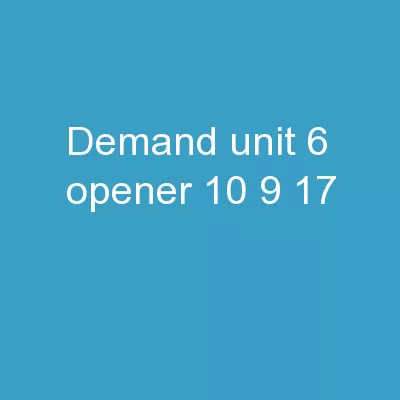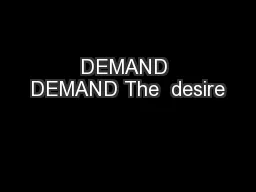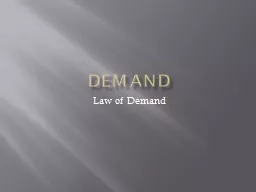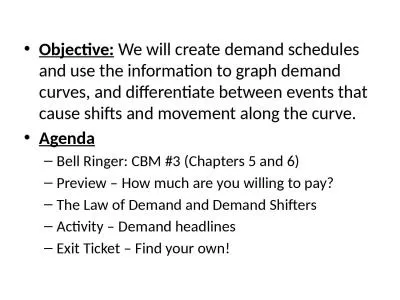PPT-Demand Unit 6 Opener: 10/9/17
Author : pamella-moone | Published Date : 2018-11-22
Copy the definition and draw a picture that comes to mind when you see this definition Demand is the desire willingness and ability to buy a good or service demand
Presentation Embed Code
Download Presentation
Download Presentation The PPT/PDF document "Demand Unit 6 Opener: 10/9/17" is the property of its rightful owner. Permission is granted to download and print the materials on this website for personal, non-commercial use only, and to display it on your personal computer provided you do not modify the materials and that you retain all copyright notices contained in the materials. By downloading content from our website, you accept the terms of this agreement.
Demand Unit 6 Opener: 10/9/17: Transcript
Copy the definition and draw a picture that comes to mind when you see this definition Demand is the desire willingness and ability to buy a good or service demand schedule is a table that lists the various quantities of a product or service that someone is willing to buy over a range of possible prices. 1 1 1 1 2 ? 2 ? 3 longer than the rebid suit also forcing... responder must bid at least one more time. One of the first things you were taught about bridge biddin This module covers the relationships between price and quantity. , maximum willing to buy, maximum reservation price, profit maximizing price, and price elasticity, assuming a linear relationship between price and demand. What is . denser. a pound of feathers or a pound of bricks. ?. Complete . Comparing Cubes. OPENER . Complete . Comparing Cubes. It Sinks, It Floats. Controls, Variables, Graphing skills. Content Objectives. 2016. When was the last time you had traffic like this? . Last year thousands of happy KISS & Mix listeners and their families got their Wisconsin Dells Season Opener Coupon Book at events all over Southeast Wisconsin! These valuable cards get them FREE and discounted attractions, hotels, restaurants and gifts, so they start lining up early! It’s the perfect way to promote your locations, goods or services to eager shoppers!. In what ways have we seen this law of supply and Demand played out in class?. Homework: Community Service Project Proposal. Write 1 paragraph on What you propose to do for Community Service. Be sure to include:. Mr. Henry. AP Economics. Understanding Definitions:. Which stretches or changes, more – something that is elastic or inelastic?. Something that is elastic…. Law of Demand:. other things equal, consumers will buy more of a product when its price declines and less when its price increases.. In what ways have we seen this law of supply and Demand played out in class?. Homework: Community Service Project Proposal. Write 1 paragraph on What you propose to do for Community Service. Be sure to include:. , . ability. , and . willingness. to buy a product.. Law of Demand. Price and demand are inverse.. As price goes up = demand goes down. As price goes down = demand goes up. DEMAND SCHEDULE. A listing that shows corresponding prices and quantities demanded.. Demand. Price and Quantity. Quantity Demanded. Law of Demand. Determinants of Demand. Demand. Demand is on overall indication of a consumers (buyers/purchasers) . desire. and . ability. to purchase a given good or service. 1) You and a partner will design a t-shirt that you think will sell amongst your peers. You will have about 7 minutes to design your product. 2) Once you have your design, collect your data. Go around the class and present your t-shirt. Ask what price they would be willing to pay for your shirt.. mean?. What is . time. ?. How would you describe something moving?. Opener 8/23. What is the point of units?. What are the units for position and time?. 3. Depict the following story as a graph (be sure to label graphs!):. Agenda. Bell Ringer: CBM #3 (Chapters 5 and 6). Preview – How much are you willing to pay?. The Law of Demand . and . Demand Shifters. Activity . – Demand . headlines. Exit Ticket – Find your own!. Demand and Supply are . most fundamental concepts of economics and it is the backbone of a market . economy. . Demand . refers to how much (quantity) of a product or service is desired by buyers. . ANH2022 – Learning Labs. Chen Zhen . University of Georgia . Theory of Consumer Economics. . First principle: when price goes up, demand comes down. . If you plot price on the vertical axis against demand on the horizontal axis, you get what we...
Download Document
Here is the link to download the presentation.
"Demand Unit 6 Opener: 10/9/17"The content belongs to its owner. You may download and print it for personal use, without modification, and keep all copyright notices. By downloading, you agree to these terms.
Related Documents














